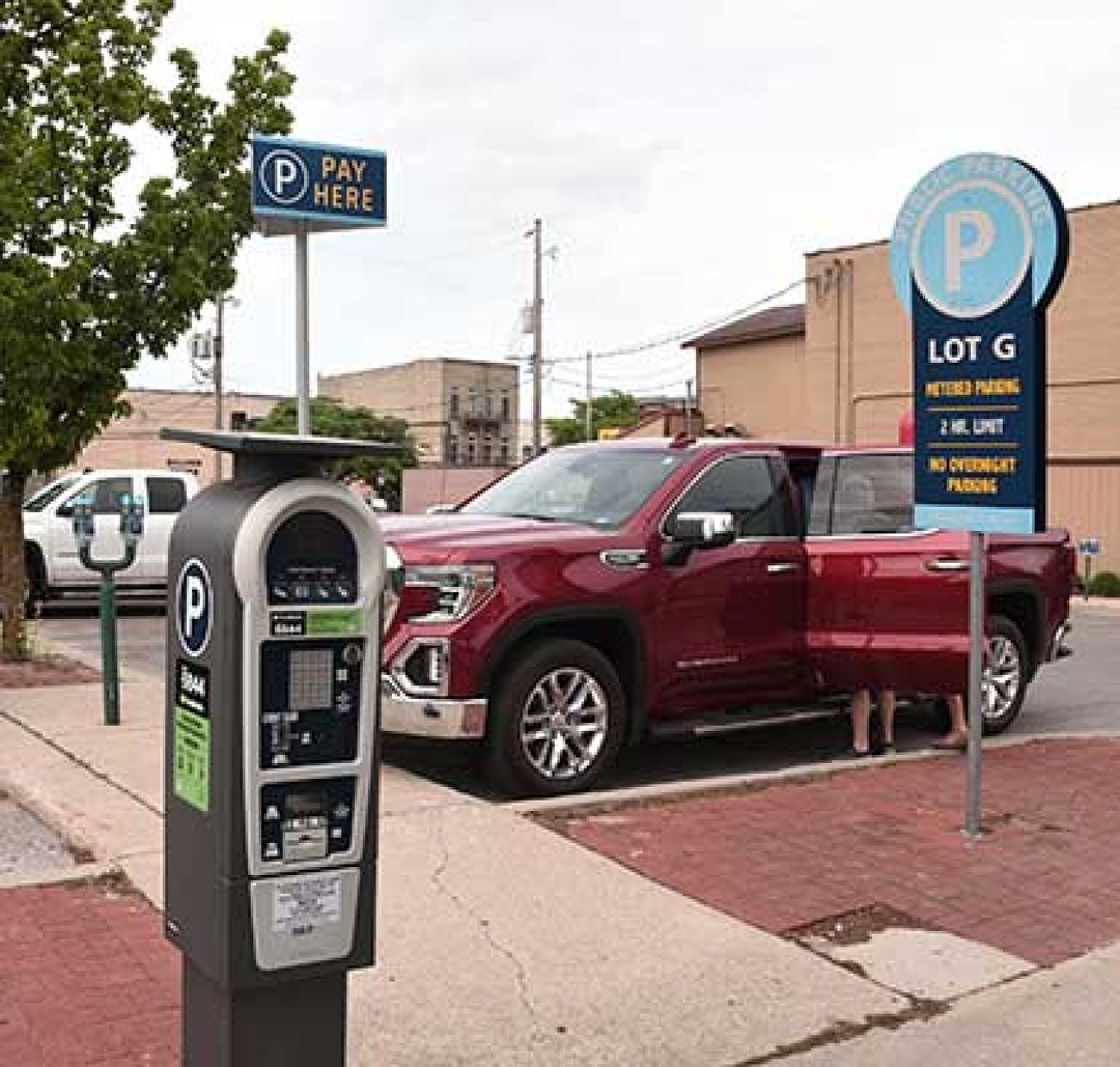In Traverse City, a small parking lot offers hope for workforce housing

A parking lot just a couple minutes’ walk from Traverse City’s thriving Front Street has room for 26 vehicles, but city officials have bigger plans for it.
In the hands of the right developer, Parking Lot O could become new store space and four stories of rental housing above it for year-round residents in a city that’s one of the most popular tourist destinations in Michigan but struggles with affordable housing.
Real-estate pressure isn’t new to the beachfront community on Grand Traverse Bay, where high-end condominium development targets the luxury market and long-term rental housing is in short supply.
Related:
- A Michigan mall’s transformation: From Macy’s to self-storage
- Northern Michigan resort town confronts shortage of year-round housing
- Coronavirus kept us home, igniting real estate frenzy in northern Michigan
- Affordable housing crisis hits rural Michigan. Newaygo project offers hope.
But the latest step toward a solution is a fast-track plan by the city to sell Parking Lot O, as long as new apartments, maybe two dozen of them or more, are part of the plan.
As the city pursues a deal, officials know a parking lot project won’t alleviate rising housing prices, particularly downtown, where new condos are selling for $1 million-plus, City Commissioner Tim Werner said.

But it’s a start, he added.
“We realize it’s not a silver bullet,” he said. “We’re trying to show what’s possible.”
Developers have until June 24 to tell the city if they’re interested in buying 159 E. State St., along with what they’d pay for the property, what size apartments they envision and the amount of rent they’d expect to charge. Once the city has that information, along with a concept plan, prospective renderings and the development team’s qualifications, officials will evaluate proposals.
By July 8, the city hopes to name finalists, and a decision could follow in August.
The community has discussed housing for a “couple of decades, at least,” but the timing is right to make a decision on this parking lot, Werner said.
City officials seem aligned on the goal of bringing more workforce housing to downtown. By starting with the small parking lot deal, approved unanimously in spring, the city is signaling that it’s willing to both take some action now and learn how to set up future deals for city-owned land. Three additional parking lots could be targeted for redevelopment, including Parking Lot G, on the same block, where the Downtown Development Authority eyes still more possible development.

“We’ve been trying to send a signal that this is our first attempt (at selling city-owned land) and we will try to do more,” Werner said. “It’s not like this is our one piece of property.”
The goals for the projects include maximizing new housing units, while minimizing the new building’s carbon footprint and parking. Special consideration will be given to projects that support bicycles and public transportation instead of autos. Other priorities include ground-floor retail space and favoring long-term rentals over short-term rentals.
Ultimately, city officials want to see most of the new rental units to be priced for people who are making 70 percent to 120 percent of the area median income for Grand Traverse County, which was $65,041 in 2019.
Under that calculation, people earning from $45,528 to $78,049 would be eligible to rent at rates from just under $1,100 per month to about $1,700.
New apartments at those rates would rent quickly, said Carolyn Ulstad, transportation program manager for Groundwork Center for Resilient Communities, a nonprofit based in Traverse City.
“There are just not enough housing options,” Ulstad said. “... I see a desperate need for what we call ‘the missing middle.’”
Traverse City is the largest city in the northern Lower Peninsula, with a population of 15,738 in 2019, after growing 6.8 percent over the previous decade.
The city had 7,423 housing units in 2019, and records show it added 158 that year, 124 in 2020 and 183 so far this year — the most in five years. Most were condominiums.
In the past year, thanks to a heated housing market, typical housing prices have increased 14 percent to $315,055, according to Zillow.com.
That price would be out of reach for a person or couple making $80,000, if they could even find a house for sale. Many in the community say few listings and buyers seeking second homes or short-term rentals are pressuring the market.
At the same time, there are not enough rentals, Ulstad said, notably as one apartment complex recently announced it would convert its rentals to condos.
The shortage of rental housing is catching the attention of the city’s business owners, downtown advocates and others who see an escalating need for moderately priced homes in the city.
Some, like Kevin Endres, doubt the city will be able to sell the land to fit its vision. A commercial real estate broker with Three West, Endres said the market for downtown property is “huge” as developers compete for rare development sites. The situation, he said, is similar to other in-demand city centers in Michigan, like Grand Rapids and Ann Arbor, where higher-end homes are the result.
The cost of development is so high — due in part to the cost of building materials — that even if the city offered a discount on the land, building a mix of retail property and affordable apartments is unlikely to be viable soon, Endres said.
“Even if they give developers the land, it makes the numbers hard to beat,” Endres said.
At the same time, he said any loss of parking will be a blow to downtown, which is trying to attract new office tenants and stay accessible to visitors.
Not all business owners agree.
“We need housing more than we need parking,” said Karen Hilt, owner of My Secret Stash.
The store that specializes in Michigan-made items is located on Cass Street in the same block as Parking Lot O. Like many other small businesses in Traverse City, it’s struggling to attract workers. Hilt said the prospective workforce ends up living too far from downtown for them to seek work there.

Adding housing for those workers has an exponential benefit, Hilt said. Unlike seasonal visitors or part-time residents, “they will be shopping and eating and working year-round here.
“They’ll become part of the community.”
Jean Derenzy, executive director of the city’s Downtown Development Authority, said activity downtown has been brisk over the past few years, with a mix of public and private investments.
One recent project is the $25.3 million mixed use building that will house up to 91 mixed-income apartments. The developer, GLC Northern Michigan Pine LLC, is an entity of Indiana-based Great Lakes Capital, which received a $2.9 million community revitalization loan from the state to build the project along the Boardman River.
Identifying the surface parking lots as surplus while planning to build parking structures allows the city to increase the vibrancy downtown, Ulstad said. Part of that includes creating ways for people who live in and near downtown to not need daily access to autos.
Werner said he doesn’t yet know if the city’s proposal will be effective. It’s been distributed across the United States, and he said Traverse City’s image may draw a national investment audience.
In the meantime, as the city waits to see the results from putting Parking Lot O on the market, Werner said he knows the process may not be perfect. That’s OK, he said.
“We’ve got to get this right,” he said. “But it isn’t going to be perfect. This is our first one. We’ll try to do it really well, and then adjust….
“We’ll learn from it and keep going.”
Business Watch
Covering the intersection of business and policy, and informing Michigan employers and workers on the long road back from coronavirus.
- About Business Watch
- Subscribe
- Share tips and questions with Bridge Business Editor Paula Gardner
Thanks to our Business Watch sponsors.
Support Bridge's nonprofit civic journalism. Donate today.
See what new members are saying about why they donated to Bridge Michigan:
- “In order for this information to be accurate and unbiased it must be underwritten by its readers, not by special interests.” - Larry S.
- “Not many other media sources report on the topics Bridge does.” - Susan B.
- “Your journalism is outstanding and rare these days.” - Mark S.
If you want to ensure the future of nonpartisan, nonprofit Michigan journalism, please become a member today. You, too, will be asked why you donated and maybe we'll feature your quote next time!




